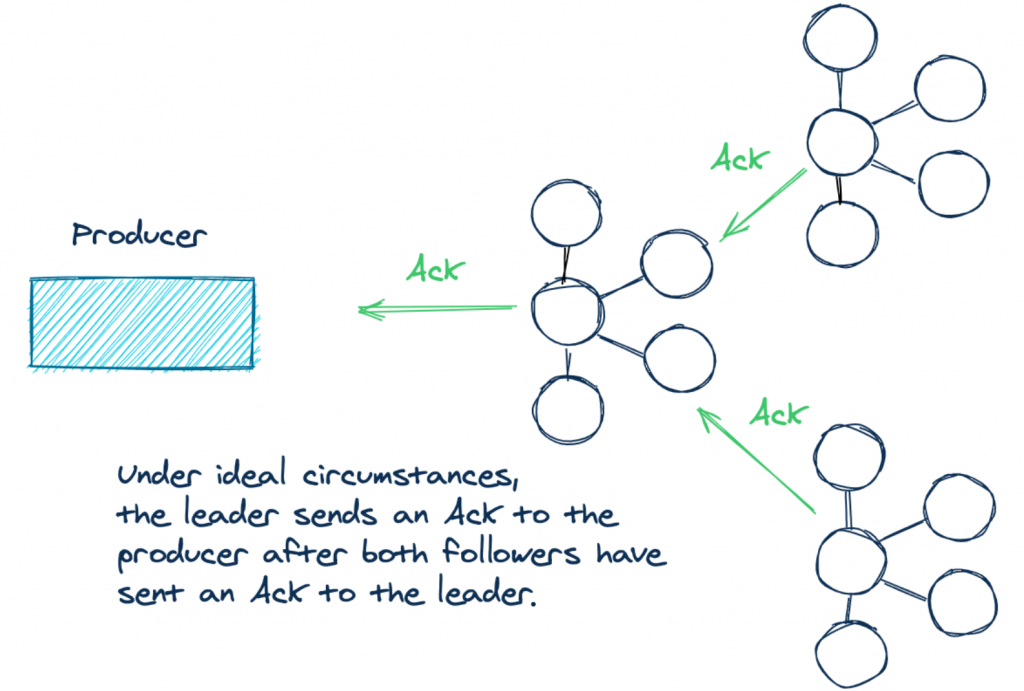问题
用过 Kafka 的同学应该都知道,每个 Topic 一般会有很多个 partitions。为了使得我们能够及时消费消息,我们也可能会启动多个 Consumer 去消费,而每个 Consumer 又会启动一个或多个streams去分别消费 Topic 对应分区中的数据。我们又知道,Kafka 存在 Consumer Group 的概念,也就是 group.id 一样的 Consumer,这些 Consumer 属于同一个Consumer Group,组内的所有消费者协调在一起来消费订阅主题(subscribed topics)的所有分区(partition)。当然,每个分区只能由同一个消费组内的一个consumer来消费。那么问题来了,同一个 Consumer Group 里面的 Consumer 是如何知道该消费哪些分区里面的数据呢?
如上图,Consumer1 为啥消费的是 Partition0 和 Partition2,而不是 Partition0 和 Partition3?这就涉及到 Kafka 内部分区分配策略(Partition Assignment Strategy)了。
在 Kafka 内部存在两种默认的分区分配策略:Range 和 RoundRobin。当以下事件发生时,Kafka 将会进行一次分区分配:
- 同一个 Consumer Group 内新增消费者
- 消费者离开当前所属的Consumer Group,包括shuts down 或 crashes
- 订阅的主题新增分区
将分区的所有权从一个消费者移到另一个消费者称为重新平衡(rebalance),如何rebalance就涉及到本文提到的分区分配策略。下面我们将详细介绍 Kafka 内置的两种分区分配策略。本文假设我们有个名为 T1 的主题,其包含了10个分区,然后我们有两个消费者(C1,C2)来消费这10个分区里面的数据,而且 C1 的 num.streams = 1,C2 的 num.streams = 2。
Range strategy
Range策略是对每个主题而言的,首先对同一个主题里面的分区按照序号进行排序,并对消费者按照字母顺序进行排序。在我们的例子里面,排完序的分区将会是0, 1, 2, 3, 4, 5, 6, 7, 8, 9;消费者线程排完序将会是C1-0, C2-0, C2-1。然后将partitions的个数除于消费者线程的总数来决定每个消费者线程消费几个分区。如果除不尽,那么前面几个消费者线程将会多消费一个分区。在我们的例子里面,我们有10个分区,3个消费者线程, 10 / 3 = 3,而且除不尽,那么消费者线程 C1-0 将会多消费一个分区,所以最后分区分配的结果看起来是这样的:
C1-0 将消费 0, 1, 2, 3 分区
C2-0 将消费 4, 5, 6 分区
C2-1 将消费 7, 8, 9 分区
假如我们有11个分区,那么最后分区分配的结果看起来是这样的:
C1-0 将消费 0, 1, 2, 3 分区
C2-0 将消费 4, 5, 6, 7 分区
C2-1 将消费 8, 9, 10 分区
假如我们有2个主题(T1和T2),分别有10个分区,那么最后分区分配的结果看起来是这样的:
C1-0 将消费 T1主题的 0, 1, 2, 3 分区以及 T2主题的 0, 1, 2, 3分区
C2-0 将消费 T1主题的 4, 5, 6 分区以及 T2主题的 4, 5, 6分区
C2-1 将消费 T1主题的 7, 8, 9 分区以及 T2主题的 7, 8, 9分区
可以看出,C1-0 消费者线程比其他消费者线程多消费了2个分区,这就是Range strategy的一个很明显的弊端。
RoundRobin strategy
使用RoundRobin策略有两个前提条件必须满足:
- 同一个Consumer Group里面的所有消费者的num.streams必须相等;
- 每个消费者订阅的主题必须相同。
所以这里假设前面提到的2个消费者的num.streams = 2。RoundRobin策略的工作原理:将所有主题的分区组成 TopicAndPartition 列表,然后对 TopicAndPartition 列表按照 hashCode 进行排序,这里文字可能说不清,看下面的代码应该会明白:
val allTopicPartitions = ctx.partitionsForTopic.flatMap { case(topic, partitions) =>
info("Consumer %s rebalancing the following partitions for topic %s: %s"
.format(ctx.consumerId, topic, partitions))
partitions.map(partition => {
TopicAndPartition(topic, partition)
})
}.toSeq.sortWith((topicPartition1, topicPartition2) => {
/*
* Randomize the order by taking the hashcode to reduce the likelihood of all partitions of a given topic ending
* up on one consumer (if it has a high enough stream count).
*/
topicPartition1.toString.hashCode < topicPartition2.toString.hashCode
})
最后按照round-robin风格将分区分别分配给不同的消费者线程。
在我们的例子里面,假如按照 hashCode 排序完的topic-partitions组依次为T1-5, T1-3, T1-0, T1-8, T1-2, T1-1, T1-4, T1-7, T1-6, T1-9,我们的消费者线程排序为C1-0, C1-1, C2-0, C2-1,最后分区分配的结果为:
C1-0 将消费 T1-5, T1-2, T1-6 分区;
C1-1 将消费 T1-3, T1-1, T1-9 分区;
C2-0 将消费 T1-0, T1-4 分区;
C2-1 将消费 T1-8, T1-7 分区;
多个主题的分区分配和单个主题类似,这里就不在介绍了。
根据上面的详细介绍相信大家已经对Kafka的分区分配策略原理很清楚了。不过遗憾的是,目前我们还不能自定义分区分配策略,只能通过partition.assignment.strategy参数选择 range 或 roundrobin。partition.assignment.strategy参数默认的值是range。
- RoundRobin:
The round-robin partition assignor lays out all the available partitions and all the available consumer threads. It then proceeds to do a round-robin assignment from partition to consumer thread. If the subscriptions of all consumer instances are identical, then the partitions will be uniformly distributed. (i.e., the partition ownership counts will be within a delta of exactly one across all consumer threads.)(For simplicity of implementation) the assignor is allowed to assign a given topic-partition to any consumer instance and thread-id within that instance. Therefore, round-robin assignment is allowed only if:
a) Every topic has the same number of streams within a consumer instance
b) The set of subscribed topics is identical for every consumer instance within the group. - Range:
Range partitioning works on a per-topic basis. For each topic, we lay out the available partitions in numeric order and the consumer threads in lexicographic order. We then divide the number of partitions by the total number of consumer streams (threads) to determine the number of partitions to assign to each consumer. If it does not evenly divide, then the first few consumers will have one extra partition. For example, suppose there are two consumers C1 and C2 with two streams each, and there are five available partitions (p0, p1, p2, p3, p4). So each consumer thread will get at least one partition and the first consumer thread will get one extra partition. So the assignment will be: p0 -> C1-0, p1 -> C1-0, p2 -> C1-1, p3 -> C2-0, p4 -> C2-1
原创文章版权归过往记忆大数据(过往记忆)所有,未经许可不得转载。
本文链接: 【Kafka分区分配策略(Partition Assignment Strategy)】(https://www.iteblog.com/archives/2209.html)









Kafka消费者端好像不支持线程并发消费,那么例子中消费者的多个线程存在的意义是啥?
你应该理解错文章的意思了。
我想知道这个"C1 的 num.streams = 1"里的streams是什么 是kafka streams么 ?应该不是它把